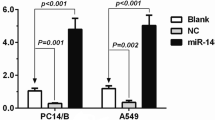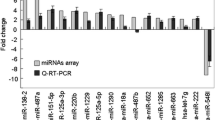Abstract
Purpose
To identify the expression of miR-520a-3p and AKT1 in non-small cell lung cancer cells (NSCLC) and the mechanism in inhibiting cell invasion and metastasis by targeting NF-kappaB signaling pathway.
Methods
Bioinformatics analysis and dual luciferase reporter gene assay were used to predict and verify the targeting relationship between miR-520a-3p and AKT1. EdU assay was used to detect the proliferation of NSCLC cells. Flow cytometry detected the apoptosis of NSCLC cells. Transwell assay tested the invasion ability of NSCLC cells. qRT-PCR measured the expression of miR-520a-3p and AKT1 mRNA in NSCLC cells; while western blotting was adopted to detect the protein expressions of AKT1, Ki67, CyclinD1, Bax, Bcl-2, MMP-2, MMP-9, NF-kB p65, IkBs kinase (IKK), NF-kB inducing kinase (NIK).
Results
Bioinformatics analysis suggested that miR-520a-3p could target AKT1. miR-520a-3p could regulate the expression of AKT1 negatively. Compared to mimic-NC group, miR-520a-3p mimic group had increased expressions of miR-520a-3p and Bax, while decreased expressions of AKT1, Ki67, CyclinD1, Bcl-2, MMP-2, MMP-9, NF-kB p65, IKK and NIK, reduced cell proliferation, invasion, and increased cell apoptosis rate (all P < 0.05). Compared to inhibitor NC group, miR-520a-3p inhibitor group had decreased expressions of miR-520a-3p and Bax, but increased expressions of AKT1, Ki67, CyclinD1, Bcl-2, MMP-2, MMP-9, NF-kB p65, IKK and NIK, promoted cell proliferation, invasion, and suppressed cell apoptosis rate (all P < 0.05).
Conclusion
Overexpression of miR-520a-3p can target and downregulate the expression of AKT1 to inhibit the invasion and metastasis of NSCLC via suppressing the activation of NF-kappaB signaling pathway.






Similar content being viewed by others
References
Nasim F, Sabath BF, Eapen GA. Lung cancer. Med Clin North Am. 2019;103:463–73.
Mao Y, Yang D, He J, Krasna MJ. Epidemiology of lung cancer. Surg Oncol Clin N Am. 2016;25:439–45.
Osmani L, Askin F, Gabrielson E, et al. Current WHO guidelines and the critical role of immunohistochemical markers in the subclassification of non-small cell lung carcinoma (NSCLC): moving from targeted therapy to immunotherapy. Semin Cancer Biol. 2018;52:103–9.
Patil S, Rathnum KK. Management of leptomeningeal metastases in non-small cell lung cancer. Indian J Cancer. 2019;56:S1–9.
Torre LA, Siegel RL, Jemal A. Lung cancer statistics. Adv Exp Med Biol. 2016;893:1–19.
Duma N, Santana-Davila R, Molina JR. Non-small cell lung cancer: epidemiology, screening, diagnosis, and treatment. Mayo Clin Proc. 2019;94:1623–40.
Zheng H, Zhan Y, Liu S, et al. The roles of tumor-derived exosomes in non-small cell lung cancer and their clinical implications. J Exp Clin Cancer Res. 2018;37:226.
Yang S, Liu Y, Li MY, et al. FOXP3 promotes tumor growth and metastasis by activating Wnt/β-catenin signaling pathway and EMT in non-small cell lung cancer. Mol Cancer. 2017;16:124.
Mishra DK, Miller RA, Pence KA, et al. Small cell and non small cell lung cancer form metastasis on cellular 4D lung model. BMC Cancer. 2018;18:441.
Guo Y, Jiang M, Zhao X, et al. Cyclophilin A promotes non-small cell lung cancer metastasis via p38 MAPK. Thorac Cancer. 2018;9:120–8.
Li W, Yu X, Ma X, et al. Deguelin attenuates non-small cell lung cancer cell metastasis through inhibiting the CtsZ/FAK signaling pathway. Cell Signal. 2018;50:131–41.
Xiao C, Pan C, Liu E, et al. Differences of microRNA expression profiles between monozygotic twins’ blood samples. Forensic Sci Int Genet. 2019;41:152–8.
Vossen CY, van Hylckama VA, et al. Identification of coagulation gene 3′UTR variants that are potentially regulated by microRNAs. Br J Haematol. 2017;177:782–90.
Goradel NH, Mohammadi N, Haghi-Aminjan H, et al. Regulation of tumor angiogenesis by microRNAs: State of the art. J Cell Physiol. 2019;234:1099–110.
Cao W, Cheng W, Wu W. MicroRNAs reprogram tumor immune response. Methods Mol Biol. 2018;1699:67–74.
Hayes J, Peruzzi PP, Lawler S. MicroRNAs in cancer: biomarkers, functions and therapy. Trends Mol Med. 2014;20:460–9.
Pan C, Liu Q, Wu X. HIF1α/miR-520a-3p/AKT1/mTOR feedback promotes the proliferation and glycolysis of gastric cancer cells. Cancer Manag Res. 2019;11:10145–56.
Zhang R, Liu R, Liu C, et al. A novel role for MiR-520a-3p in regulating EGFR expression in colorectal cancer. Cell Physiol Biochem. 2017;42:1559–74.
Liu X, Song J, Kang Y, et al. Long noncoding RNA SOX21-AS1 regulates the progression of triple-negative breast cancer through regulation of miR-520a-5p/ORMDL3 axis. J Cell Biochem. 2020;121:4601–11.
Kaymaz BT, Cetintaş VB, Aktan C, et al. MicroRNA-520a-5p displays a therapeutic effect upon chronic myelogenous leukemia cells by targeting STAT3 and enhances the anticarcinogenic role of capsaicin. Tumour Biol. 2014;35:8733–42.
Liu F, Gong R, He B, et al. TUSC2P suppresses the tumor function of esophageal squamous cell carcinoma by regulating TUSC2 expression and correlates with disease prognosis. BMC Cancer. 2018;18:894.
Lv X, Yao L, Nie YQ, et al. MicroRNA-520a-3p suppresses non-small-cell lung carcinoma by inhibition of High Mobility Group Box 1 (HMGB1). Eur Rev Med Pharmacol Sci. 2018;22(6):1700–8.
Liu Y, Miao L, Ni R, et al. microRNA-520a-3p inhibits proliferation and cancer stem cell phenotype by targeting HOXD8 in non-small cell lung cancer. Oncol Rep. 2016;36(6):3529–35.
Yu J, Tan Q, Deng B, et al. The microRNA-520a-3p inhibits proliferation, apoptosis and metastasis by targeting MAP3K2 in non-small cell lung cancer. Am J Cancer Res. 2015;5(2):802–11.
Lv X, Li CY, Han P, et al. MicroRNA-520a-3p inhibits cell growth and metastasis of non-small cell lung cancer through PI3K/AKT/mTOR signaling pathway. Eur Rev Med Pharmacol Sci. 2018;22(8):2321–7.
Vergadi E, Ieronymaki E, Lyroni K, et al. Akt signaling pathway in macrophage activation and M1/M2 polarization. J Immunol. 2017;198:1006–14.
Manning BD, Toker A. AKT/PKB signaling: navigating the network. Cell. 2017;169:381–405.
Du J, Zhang L, Wang Z, et al. Exendin-4 induces myocardial protection through MKK3 and Akt-1 in infarcted hearts. Am J Physiol Cell Physiol. 2016;310:C270–83.
Liu X, Zhao P, Wang X, et al. Celastrol mediates autophagy and apoptosis via the ROS/JNK and Akt/mTOR signaling pathways in glioma cells. J Exp Clin Cancer Res. 2019;38:184.
Zhang C, Zhang M, Ge S, et al. Reduced m6A modification predicts malignant phenotypes and augmented Wnt/PI3K-Akt signaling in gastric cancer. Cancer Med. 2019;8:4766–81.
Narayanankutty A. PI3K/ Akt/ mTOR pathway as a therapeutic target for colorectal cancer: a review of preclinical and clinical evidence. Curr Drug Targets. 2019;20:1217–26.
Cahill KE, Morshed RA, Yamini B. Nuclear factor-κB in glioblastoma: insights into regulators and targeted therapy. Neuro Oncol. 2016;18:329–39.
Ni SJ, Zhao LQ, Wang XF, et al. CBX7 regulates stem cell-like properties of gastric cancer cells via p16 and AKT-NF-κB-miR-21 pathways. J Hematol Oncol. 2018;11:17.
Cildir G, Low KC, Tergaonkar V. Noncanonical NF-κB signaling in health and disease. Trends Mol Med. 2016;22:414–29.
Soleimani A, Rahmani F, Ferns GA, et al. Role of the NF-κB signaling pathway in the pathogenesis of colorectal cancer. Gene. 2020;726:144132.
Chen T, Wang Y, Xu Z, et al. Epstein-Barr virus tegument protein BGLF2 inhibits NF-κB activity by preventing p65 Ser536 phosphorylation. FASEB J. 2019;33:10563–76.
Le F, Zhang JY, Liu W, et al. The levels of NF-κB p50 and NF-κB p65 play a role in thyroid carcinoma malignancy in vivo. J Int Med Res. 2018;46:4092–9.
Ferrara R, Mezquita L, Texier M, et al. Hyperprogressive disease in patients with advanced non-small cell lung cancer treated with PD-1/PD-L1 inhibitors or with single-agent chemotherapy. JAMA Oncol. 2018;4:1543–52.
Liu S, Li S, Hai J, et al. Targeting HER2 aberrations in non-small cell lung cancer with osimertinib. Clin Cancer Res. 2018;24:2594–604.
Zhou F, Geng J, Xu S, et al. FAM83A signaling induces epithelial-mesenchymal transition by the PI3K/AKT/Snail pathway in NSCLC. Aging. 2019;11:6069–88.
Singh V, Ram M, Kumar R, Prasad R, Roy BK, Singh KK. Phosphorylation: implications in cancer. Protein J. 2017;36:1–6.
Shiloh R, Bialik S, Kimchi A. Ser289 phosphorylation activates both DAPK1 and DAPK2 but in response to different intracellular signaling pathways. Cell Cycle. 2019;18:1169–76.
Keklikoglou I, Koerner C, Schmidt C, et al. MicroRNA-520/373 family functions as a tumor suppressor in estrogen receptor negative breast cancer by targeting NF-κB and TGF-β signaling pathways. Oncogene. 2012;31:4150–63.
Lu Q, Lu M, Li D, Zhang S. MicroRNA-34b promotes proliferation, migration and invasion of Ewing’s sarcoma cells by downregulating Notch1. Mol Med Rep. 2018;18:3577–88.
Ding L, Jiang Z, Chen Q, et al. A functional variant at miR-520a binding site in PIK3CA alters susceptibility to colorectal cancer in a Chinese Han population. Biomed Res Int. 2015;2015:373252.
Gao HY, Wang W, Luo XG, et al. Screening of prognostic risk microRNAs for acute myeloid leukemia. Hematology. 2018;23:747–55.
Zhang B, Yu L, Han N, et al. LINC01116 targets miR-520a-3p and affects IL6R to promote the proliferation and migration of osteosarcoma cells through the Jak-stat signaling pathway. Biomed Pharmacother. 2018;107:270–82.
Bi CL, Zhang YQ, Li B, Guo M, Fu YL. MicroRNA-520a-3p suppresses epithelial-mesenchymal transition, invasion, and migration of papillary thyroid carcinoma cells via the JAK1-mediated JAK/STAT signaling pathway. J Cell Physiol. 2019;234:4054–67.
Ye WG, Yao QL, Zhang MX, et al. miR-520a regulates ErbB4 expression and suppresses proliferation and invasion of esophageal squamous cell carcinoma. Nan Fang Yi Ke Da Xue Xue Bao. 2014;34:164–8.
Wang X, Wang P, Zhu Y, et al. MicroRNA-520a attenuates proliferation of Raji cells through inhibition of AKT1/NF-κB and PERK/eIF2α signaling pathway. Oncol Rep. 2016;36:1702–8.
Lieber M, Smith B, Szakal A, et al. A continuous tumor-cell line from a human lung carcinoma with properties of type II alveolar epithelial cells. Int J Cancer. 1976;17(1):62–70.
Golding B, Luu A, Jones R, et al. The function and therapeutic targeting of anaplastic lymphoma kinase (ALK) in non-small cell lung cancer (NSCLC). Mol Cancer. 2018;17:52.
Singh A, Venkannagari S, Oh KH, et al. Small molecule inhibitor of NRF2 selectively intervenes therapeutic resistance in KEAP1-deficient NSCLC tumors. ACS Chem Biol. 2016;11:3214–25.
Acknowledgements
We would like to acknowledge the reviewers for their helpful comments on this paper.
Author information
Authors and Affiliations
Contributions
XF conceived and designed the study, and drafted the manuscript. JZ and HS collected, analyzed and interpreted the experimental data. FS revised the manuscript for important intellectual content. All authors read and approved the final manuscript.
Corresponding author
Ethics declarations
Conflict of interest
The authors declare that they have no conflict of interest.
Ethical approval
This article does not contain any studies with human participants or animals performed by any of the authors, and thus there was no need for ethical approval.
Informed consent
Not applicable.
Additional information
Publisher's Note
Springer Nature remains neutral with regard to jurisdictional claims in published maps and institutional affiliations.
Supplementary Information
Below is the link to the electronic supplementary material.

12094_2022_2797_MOESM1_ESM.jpg
Supplementary file1 Figure 1. Fluorescent staining results by EdU assay to detect the proliferation of NSCLC cells after cell transfection. (JPG 4429 KB)
Rights and permissions
About this article
Cite this article
Fang, X., Shi, H. & Sun, F. The microRNA-520a-3p inhibits invasion and metastasis by targeting NF-kappaB signaling pathway in non-small cell lung cancer. Clin Transl Oncol 24, 1569–1579 (2022). https://doi.org/10.1007/s12094-022-02797-9
Received:
Accepted:
Published:
Issue Date:
DOI: https://doi.org/10.1007/s12094-022-02797-9




